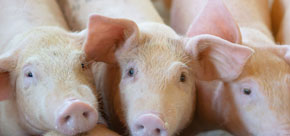Pigs Standards
OUTDOOR PIGS Version 5.1 (modified)
Click to view
Key – Those standards which have greater significance (all other standards are normal)
Recommendation – Those which do not affect certification
New – A completely new standard which the member must now adhere to
Revised – A standard that has changed and requires the member to take some different or additional action to before
Upgraded – The standard has been upgraded to a Key standard or from a Recommendation to a full standard
Appendix – Referenced in ‘How you will be measured’. Indicates that additional information is provided in the Appendices, which are available at the end of each section.
PG.OP.1
Appropriate accommodation must be available to pigs.
How you will be measured
PG.OP.1.a
PG.OP.1.b
PG.OP.2
Bedding material must be provided within accommodation to provide thermal comfort.
PG.OP.3
Stocking density for breeding animals must not exceed 30 adult pigs per hectare.
How you will be measured
PG.OP.3.a
PG.OP.4
A training area must be used to allow new gilts, sows and boars to become accustomed to electric fences.
PG.OP.5
Facilities must be provided during warm weather to allow pigs to keep cool and minimise risk of sunburn.
PG.OP.6
Sows must be farrowed in appropriate farrowing accommodation.
How you will be measured
PG.OP.6.a
PG.OP.6.b
PG.OP.7
Fenders or similar are used to prevent very young piglets from straying.
PG.OP.8
Measures must be in place to minimise disease transmission between batches.
How you will be measured
PG.OP.8.a
PG.OP.8.b
PG.OP.9
Injurious weeds (e.g. ragwort) which pigs may access must be controlled.
PG.OP.10
A documented Wild Animal* Control Plan is implemented to minimise wild animal access to pigs.
How you will be measured
PG.OP.10.a
PG.OP.10.b
Wild Animal Control Plan
PG.OP.11
Where pigs are held in a collection area prior to transport it is managed appropriately.
How you will be measured
PG.OP.11.a
PG.OP.11.b
PG.OP.12
The Food Standards Agency risk assessment tool for Trichinella is applied annually to relevant units to determine controlled housing status
How you will be measured
PG.OP.12.a
PG.OP.12.b
QVRs for previous four quarters
- AHDB guidance on farrowing environment: https://ahdb.org.uk/knowledge-library/outdoor-farrowing-environment (outdoor)
- AHDB factsheets on heat stress: https://ahdb.org.uk/knowledge-library/heat-stress-outdoor-herds (outdoor herds)
- AHDB guidance on protecting your outdoor pig unit from predators: https://ahdb.org.uk/knowledge-library/protecting-your-outdoor-pig-unit-from-predators
- AHDB guidance on trichinella including testing requirements, controlled housing conditions and risks: https://ahdb.org.uk/knowledge-library/trichinella-in-pig-herds
More Standards
- OP.10 – *Wild animals include, but are not limited to, badgers, deer, feral pigs, foxes. The plan need only consider access by wild animals that are likely to be present in the area.
- OP.12 – The FSA risk assessment tool must be applied to pig units that wish to be recognised as applying controlled housing conditions where pigs over five weeks of age (excluding breeding boars and sows which must be tested at slaughter for Trichinella) have outdoor access, i.e. where pigs over five weeks are not reared in fully enclosed indoor systems. Indoor units with natural ventilation are considered fully enclosed indoor units and therefore do not need to undergo the risk assessment. Units with outdoor access in Northern Ireland that have undergone, and have evidence of, a risk assessment by DAERA do not need to undergo the FSA risk assessment by their vet.
